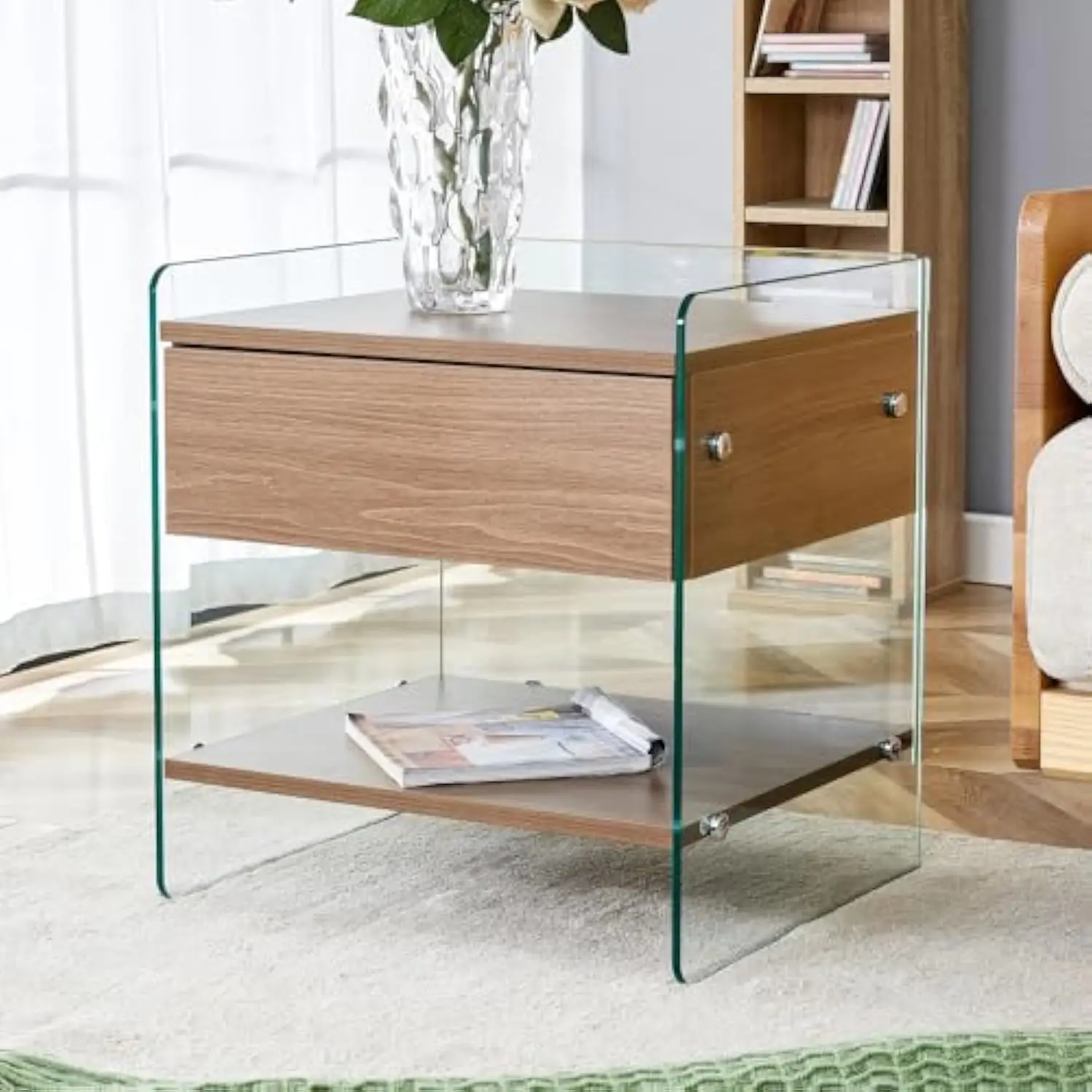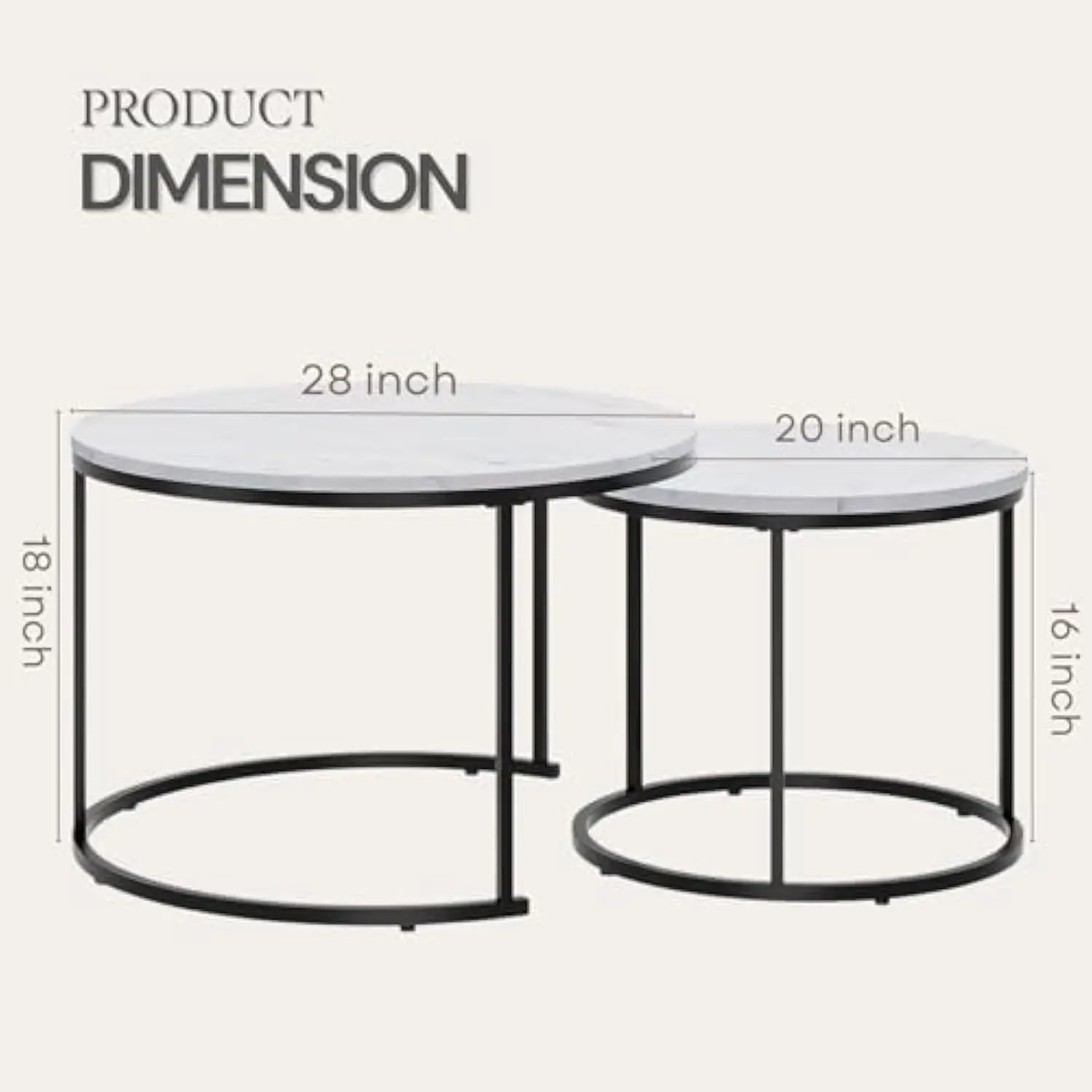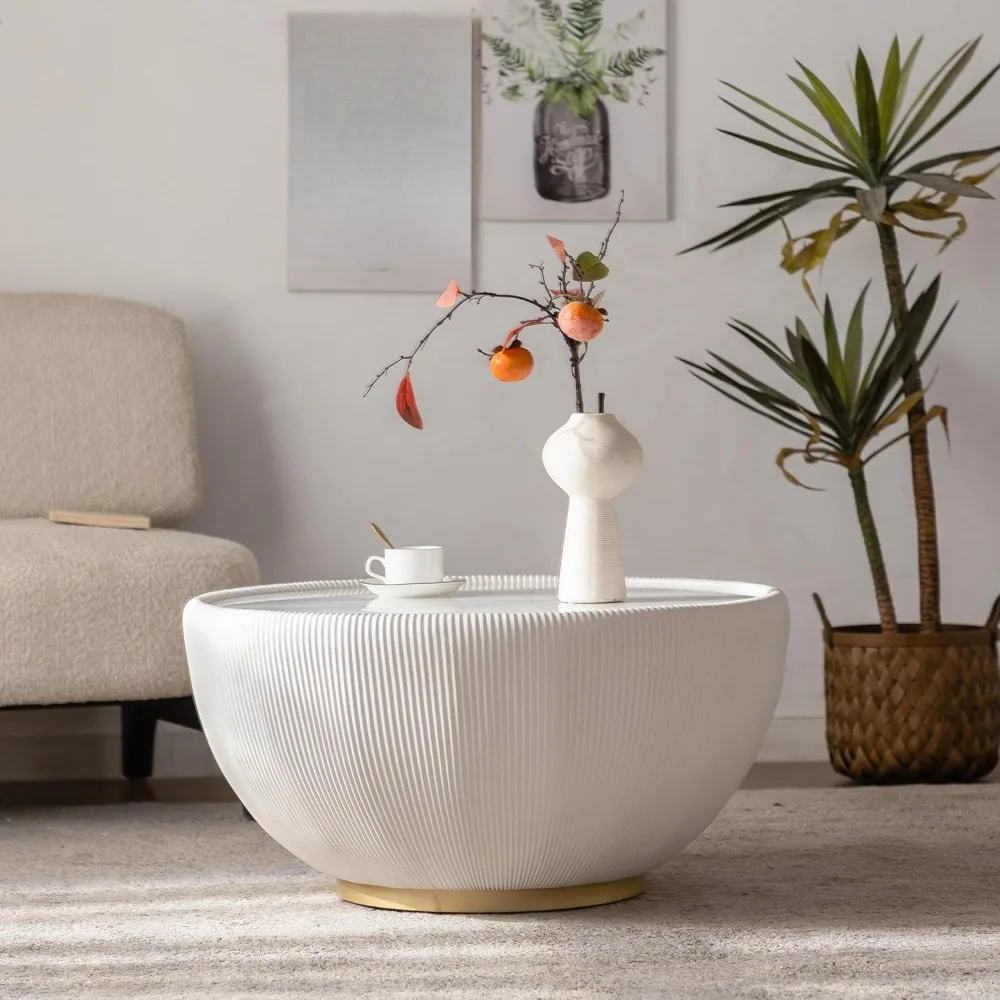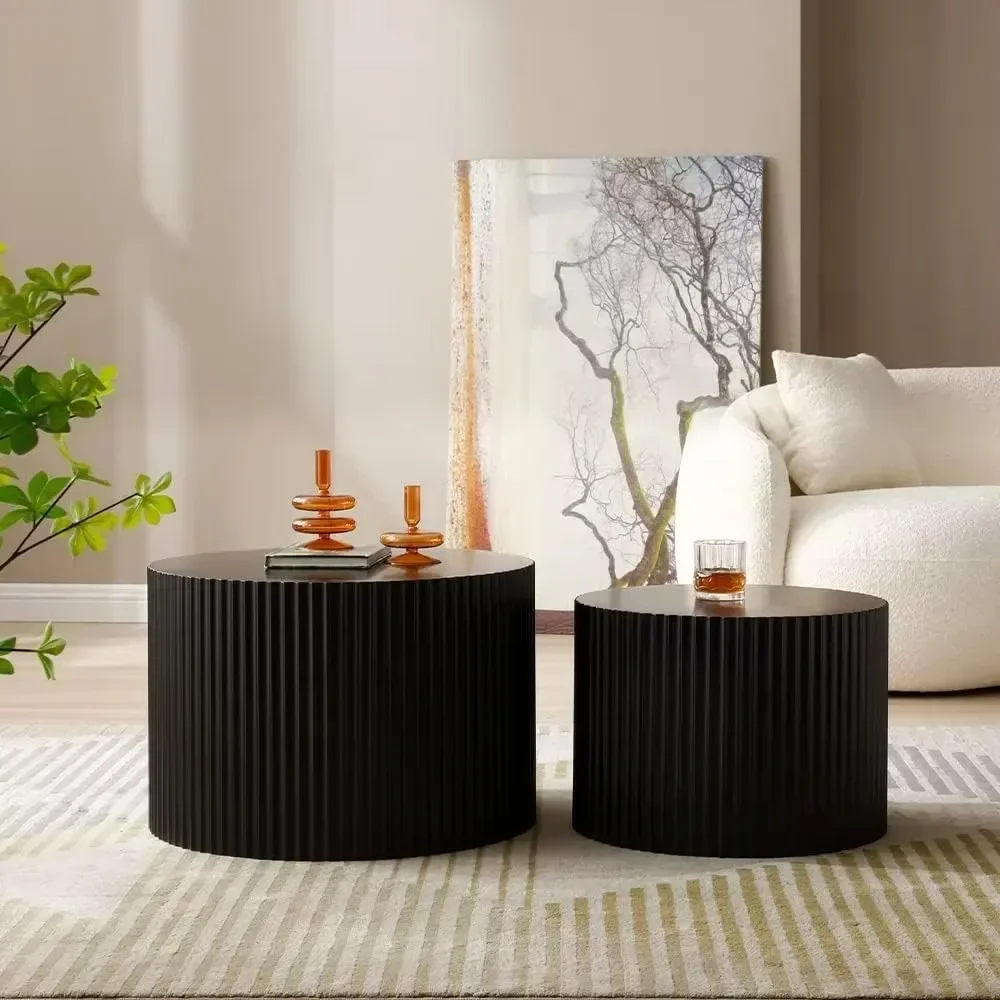Why Round Coffee Tables Make Sense for Your Space
When designing your living space, the shape of your coffee table might seem like a minor detail, but it can significantly impact how your room feels and functions. Round coffee tables have gained popularity not just for their aesthetic appeal but for their practical benefits in home design.
Round coffee tables excel at creating smooth traffic flow in living areas. Without sharp corners to navigate around, people can move more freely through the space, making round tables particularly valuable in smaller or busy rooms. The curved edges naturally guide movement, creating an intuitive path through your living area.
These tables offer several advantages over their rectangular counterparts:
- They create a sense of balance and harmony through their symmetrical shape
- They soften spaces dominated by straight lines and rectangular furniture
- They promote conversation by allowing everyone to see each other easily
- They provide greater safety, especially in homes with young children or elderly residents
The visual weight of round tables often feels lighter than rectangular ones of similar size, helping rooms appear more spacious. This effect is particularly valuable when working with intelligent black mid-century coffee tables that combine form and function in compact designs.
Finding the perfect round coffee table involves more than just selecting a style you love. The right dimensions and placement are crucial for both visual harmony and practical functionality. When chosen thoughtfully, mid-century modern round coffee tables can transform your living space while enhancing its usability.
Essential Size Guidelines for Round Coffee Tables
Determining the Perfect Diameter for Your Seating Area
Finding the right size round coffee table starts with understanding proper proportions. Interior designers commonly recommend following the two-thirds rule: your coffee table should be approximately two-thirds the length of your sofa for visual balance. This creates harmony between the two pieces without overwhelming or underwhelming the space.
For specific sofa sizes, here’s a helpful diameter guide:
| Sofa Length | Ideal Table Diameter |
|---|---|
| Small (60-70 inches) | 24-30 inches |
| Standard (72-84 inches) | 30-36 inches |
| Large/Sectional (85+ inches) | 36-42 inches |
These measurements provide a starting point, but you should also consider your room’s overall scale. In a spacious living room with high ceilings, you might opt for a slightly larger diameter to maintain proportional balance. Conversely, in compact spaces, staying on the smaller end of the range helps preserve valuable floor area.
Your living habits should influence size selection too. If you frequently entertain or use the coffee table for games and activities, a larger diameter provides more usable surface. For primarily decorative purposes or occasional use, a smaller table might suffice.
Learning proper styling black mid-century coffee table techniques can help you make the most of whatever size you choose, creating a functional yet visually appealing centerpiece for your living space.
Finding the Right Height Balance with Your Seating
The height of your coffee table plays a crucial role in both comfort and visual harmony. Most coffee tables fall between 16-19 inches tall, but the ideal height for your space depends primarily on your seating.
For maximum comfort and functionality, your coffee table should be:
– Equal to or 1-2 inches lower than your sofa seat cushions
– At a height that allows easy reaching without straining
– Proportional to surrounding furniture pieces
When your sofa has a standard seat height (typically 17-19 inches), a coffee table around 16-18 inches works perfectly. For lower, mid-century style sofas, consider tables on the shorter end of the spectrum. Conversely, higher contemporary seating may require taller tables to maintain comfortable reach distances.
The relationship between table height and sofa creates both practical and visual effects. A table that’s significantly lower than your seating creates a modern, relaxed atmosphere but might compromise functionality. A table that’s too tall can feel awkward and intrusive, making casual use uncomfortable.
For spaces with unique requirements or constraints, exploring mid-century modern small coffee tables provides options that combine appropriate height with space-saving dimensions.
Critical Clearance: Creating Comfortable Movement Around Your Table
The Ideal Distance Between Sofa and Coffee Table
Achieving the perfect distance between your sofa and coffee table balances accessibility with comfortable legroom. The industry standard recommends maintaining 12-18 inches of clearance between the edge of your seating and the table.
This seemingly small gap serves several important functions:
– Provides adequate legroom when seated
– Allows easy reaching for items on the table
– Enables comfortable entry and exit from seating
– Creates a visual breathing space between furniture pieces
You might adjust this distance based on your specific situation. If your sofa is deeper than average, you might position the table closer to the 12-inch mark so items remain within easy reach. For shallow sofas or when the room is primarily used for TV watching, the full 18 inches provides more comfortable legroom.

The best way to test this clearance is through practical experience. Try sitting in your normal position and reaching for the table—you shouldn’t need to strain or stand up. Similarly, you should be able to extend your legs comfortably without kicking the table.
Different black mid-century modern coffee table styles may require subtle adjustments to this clearance based on their base design and overall proportions to maintain the perfect balance of function and form.
Ensuring Proper Walkway Space Around Your Round Table
Beyond the immediate sofa-to-table distance, you need to consider the overall traffic flow around your coffee table. Proper walkway clearance ensures comfortable movement throughout your living space without awkward squeezing or furniture shuffling.
For comfortable circulation around your round coffee table:
– Maintain at least 24-30 inches of clearance for primary walkways
– Allow 36 inches (3 feet) between the table and other furniture pieces
– Ensure paths to doors and hallways have at minimum 30 inches of space
– Create wider clearances (36+ inches) for high-traffic areas or spaces used by people with mobility devices
To determine the best layout for your space, observe how people naturally move through the room. Pay attention to paths from entrances to seating and between different areas of your home. The circular shape of round tables can actually improve traffic flow compared to rectangular options, as demonstrated in various square round coffee table layout comparisons.
For open floor plans, clearance becomes especially important as the coffee table area may connect multiple functional zones. In more defined rooms, you might adjust clearances slightly tighter if the space is used less frequently or by fewer people.
Strategic Placement Strategies for Round Coffee Tables
Centering vs. Off-Center: Finding the Right Position
The traditional approach to coffee table placement centers the table in front of the sofa, creating perfect symmetry. This arrangement works beautifully in formal living rooms or spaces with classic design sensibilities. The centered position creates a sense of order and intentionality that many find appealing.
However, off-center placement can be equally effective in the right context. This approach works particularly well when:
– Your seating arrangement is asymmetrical
– You need to prioritize access from a particular direction
– You’re creating a more casual, relaxed atmosphere
– You want to highlight other design elements in the room
When using off-center placement, maintain visual balance by anchoring the table with other elements. A floor lamp, side table, or plant can create counterweight to prevent the room from feeling lopsided.
For maximum flexibility, consider mid-century modern nesting coffee tables that can be arranged in various configurations as your needs change. These versatile pieces allow you to experiment with both centered and off-center arrangements while adapting to different activities and occasions.
The golden ratio (approximately 1:1.618) can guide asymmetrical placement that still feels visually harmonious. This mathematical proportion has been used in design for centuries to create naturally pleasing arrangements.
Optimal Placement for Different Sofa Configurations
Your seating arrangement directly influences the ideal placement for your round coffee table. Different configurations require specific approaches to achieve both functionality and visual harmony.
For L-shaped sectionals:
– Position the table in the corner opening of the “L”
– Ensure the table is accessible from both sections of the sectional
– Consider a slightly larger diameter table to balance the substantial seating
With U-shaped conversation areas:
– Center the table in the open area of the “U”
– Choose a generous diameter that fills the space appropriately
– Maintain equal distance from all seating elements when possible
When working with a single sofa and facing chairs:
– Place the table slightly closer to the sofa than the chairs
– Ensure all seating has comfortable reaching access to the table
– Position the table to facilitate conversation across the arrangement
For floating furniture arrangements (away from walls):
– Use the coffee table to anchor and define the seating area
– Maintain consistent clearance on all sides
– Consider how the arrangement looks from all angles of approach
The beauty of round tables is their versatility—they can work with virtually any seating configuration without creating awkward corners or difficult access points.
Coordinating with Room Focal Points and Features
Your coffee table should work harmoniously with your room’s existing focal points rather than competing with them. Whether your space features a fireplace, television, window with a view, or architectural element, the table placement should complement these features.
When placing your coffee table, consider:
– Maintaining clear sightlines to the TV or fireplace
– Positioning the table at least 24 inches from a hearth for safety
– Aligning the table to frame rather than obstruct views from primary seating
– Using the table to enhance rather than distract from architectural features
In larger spaces, your coffee table can help create distinct zones without the need for walls or dividers. By anchoring a seating arrangement around a round table, you establish a clear conversation area separate from other room functions.
When dealing with multiple focal points—like a room with both a fireplace and television—the coffee table can serve as a unifying element. Position it to facilitate engagement with both features without forcing awkward neck turns or uncomfortable seating positions.
Round Coffee Tables for Specific Room Challenges
Maximizing Small Living Spaces with Round Tables
Small living rooms benefit tremendously from round coffee tables. Without sharp corners cutting into precious floor space, these tables make tight quarters feel more spacious and navigable. Their continuous curved edge means no wasted space in corners that might otherwise be difficult to access.
In compact living areas:
– Opt for tables in the 24-30 inch diameter range
– Choose glass or acrylic tables that allow light to pass through
– Select tables with slim profiles or open bases
– Consider nesting tables that can expand when needed and compact when space is at a premium

Multi-functional round coffee tables offer particular advantages in small spaces. Look for designs with storage compartments, lift-tops that convert to work surfaces, or nesting configurations that can be separated for flexible use. These features help maximizing black mid-century coffee tables in limited square footage without sacrificing style or functionality.
Remember that scale matters tremendously in small spaces. A table that’s too large can make movement difficult and the room feel cramped, while one that’s too small might appear insignificant and fail to provide adequate functional surface.
Defining Areas in Open-Concept Layouts
Open floor plans present unique challenges for furniture arrangement, as you need to create distinct zones without the benefit of walls. Round coffee tables excel at establishing clear boundaries while maintaining visual flow between areas.
In open-concept spaces, round coffee tables can:
– Anchor floating furniture arrangements away from walls
– Create visual distinction between living and dining areas
– Establish conversation zones within larger spaces
– Soften the often rectilinear nature of open floor plans
The design benefits round mid-century tables are particularly evident in open layouts, where their organic shapes provide welcome contrast to the straight lines typically found in these contemporary spaces.
When selecting a round table for an open floor plan, you often have the freedom to choose larger diameters (36+ inches) as space constraints are typically less restrictive. The more substantial presence helps define the seating area as a distinct zone within the larger room.
To further enhance zone definition, pair your round coffee table with a complementary round area rug that extends beyond the seating arrangement. This creates a visual island that clearly designates the living area from surrounding spaces.
Navigating High-Traffic Living Areas
Living rooms that serve as thoroughfares to other areas of the home benefit tremendously from round coffee tables. The absence of corners eliminates painful shin collisions and creates natural pathways around the furniture.
For busy household spaces:
– Position the table with clear understanding of traffic patterns
– Increase standard clearances by 6-12 inches where possible
– Choose sturdy, stable bases that won’t tip if bumped
– Opt for tables with smooth, potentially padded edges for safety
Round tables reduce collision risk by approximately 25-30% compared to rectangular tables of similar size, making them ideal for homes with children, pets, or frequent guests. This safety benefit alone makes them worth considering for active households.
When planning placement in high-traffic areas, observe how people naturally move through the space before finalizing your arrangement. Sometimes shifting the table even a few inches can dramatically improve flow while maintaining functional relationships with seating.
Visual Impact: How Materials Affect Perceived Space
How Table Materials Create or Limit Space
The material of your coffee table significantly impacts how much visual space it appears to occupy, regardless of its actual dimensions. This perception effect can be strategically used to make rooms feel more spacious or more intimate.
Materials that create a sense of openness:
– Glass and acrylic tops that allow you to see through the table
– Reflective surfaces that bounce light around the room
– Light-colored woods and metals that don’t visually weigh down the space
– Mixed materials with thoughtful negative space in the design
Materials that create a grounding, substantial presence:
– Solid dark woods that absorb rather than reflect light
– Natural stone tops like marble or granite
– Heavy metals like wrought iron or bronze
– Textured materials that draw visual attention
Mid-century modern glass top coffee tables exemplify how material choice can maintain functional surface area while minimizing visual weight—an ideal solution for smaller spaces or rooms that already contain substantial furniture pieces.
The finish of materials matters too. High-gloss surfaces reflect more light and generally feel less substantial than matte finishes, which absorb light and create a stronger visual presence. Consider this factor alongside color when evaluating how a table will impact your space.
Base Designs and Their Effect on Room Flow
The base or pedestal of your round coffee table significantly impacts both visual space perception and physical movement around the piece. Different designs create dramatically different effects while supporting the same tabletop.
Open-leg designs with slim profiles allow light and air to flow beneath the table, making the piece feel lighter and less substantial. These designs work particularly well in smaller spaces or rooms where you want to maintain an airy, uncluttered feeling.
Pedestal bases consolidate the table’s supporting structure into a central column, freeing up floor space and leg room around the perimeter. This design facilitates easier movement around the table and can accommodate more people when gathered for conversation.
Drum-style or solid bases create a stronger visual anchor and often provide hidden storage opportunities. While these designs have more substantial visual weight, they eliminate the possibility of clutter beneath the table and create clean, unbroken lines.

When selecting a base design, consider not just aesthetics but how people will interact with the table. Bases with splayed legs may create unexpected toe-stubbing hazards, while drum bases might limit comfortable foot positioning when seated close to the table.
Practical Application: Measuring and Selecting Your Table
Step-by-Step Measurement Guide
Finding the perfect coffee table starts with accurate measurements of your space. Follow these steps to gather the information you need for confident decision-making:
Measure your sofa length from arm to arm using a tape measure. Write down this number for reference when applying the two-thirds rule.
Measure your sofa seat height from the floor to the top of the cushion. This helps determine ideal coffee table height.
Map your room’s dimensions on graph paper or using a room planning app. Include all existing furniture positions.
Identify traffic patterns by drawing lines showing how people typically move through the space.
Use painter’s tape on the floor to outline potential coffee table placements, testing different diameters.
Test clearances by walking through the space and sitting in your normal positions to ensure comfort.
Take photos of the taped outlines from different angles to reference when shopping.
Measure distances to nearby furniture pieces, ensuring you maintain minimum clearances.
This methodical approach prevents costly mistakes and ensures your new table will function properly within your existing arrangement. Having these measurements ready when browsing mid-century modern coffee tables makes the selection process much more efficient and focused.
Quick Reference Size and Clearance Chart
Use this comprehensive chart to quickly determine the appropriate dimensions for your round coffee table based on your specific living space:
| Consideration | Small Space | Standard Space | Large Space |
|---|---|---|---|
| Sofa Length | 60-70” | 72-84” | 85”+ |
| Table Diameter | 24-30” | 30-36” | 36-42” |
| Table Height | 16-17” | 17-19” | 18-20” |
| Sofa to Table | 12-14” | 14-16” | 16-18” |
| Walkway Clearance | 24” | 30” | 36”+ |
When using this chart, start with the column that best describes your overall space, then adjust individual measurements based on your specific furniture and room configuration. For irregular rooms or unusual furniture, prioritize comfort and function over strict adherence to these guidelines.
Remember that these measurements represent ideal scenarios. You may need to compromise on certain dimensions to accommodate unique space constraints or special requirements.
Mid-Century Modern Solid Wood Coffee Tables, Mid-Century Modern Teak Coffee Tables
$879.95 Select options This product has multiple variants. The options may be chosen on the product pageMid-Century Modern Danish Coffee Tables, Mid-Century Modern Oval Coffee Tables, Mid-Century Modern Solid Wood Coffee Tables
$390.05 Select options This product has multiple variants. The options may be chosen on the product pageMid-Century Modern Coffee & End Table Sets, Mid-Century Modern Coffee Table Sets, Mid-Century Modern Oval Coffee Tables
Price range: $257.48 through $331.04 Select options This product has multiple variants. The options may be chosen on the product pageMid-Century Modern Glass Top Coffee Tables, Mid-Century Modern Glass Top Side & End Tables
$460.58 Select options This product has multiple variants. The options may be chosen on the product pageMid-Century Modern Glass Top Coffee Tables, Mid-Century Modern Vintage Coffee Tables, Mid-Century Modern Vintage Side & End Tables
$725.36 Select options This product has multiple variants. The options may be chosen on the product pageMid-Century Modern Lift Top Coffee Tables, Mid-Century Modern Square Coffee Tables
$454.73 Select options This product has multiple variants. The options may be chosen on the product page
Solving Common Space Dilemmas with Round Coffee Tables
Certain living space configurations present particular challenges. Here are solutions to common coffee table dilemmas using round designs:
Problem: My living room is long and narrow.
Solution: Choose a slightly smaller diameter round table positioned closer to the primary seating. This preserves the main walkway while maintaining functionality. Consider an oval table which combines the benefits of rounded edges with a more elongated footprint suited to rectangular rooms.
Problem: My sectional is massive compared to the rest of my furniture.
Solution: Select a larger diameter table (36-42 inches) to balance the substantial sectional. Position it centered in the open area of the sectional, ensuring all seated positions have reasonable access. A substantial base helps the table hold its visual ground against the large seating piece.
Problem: I have small children and safety is a priority.
Solution: Round tables eliminate dangerous corners entirely. Look for designs with smooth, potentially padded edges and stable bases that won’t tip easily. Avoid glass tops or choose tempered safety glass if that material is preferred for your design scheme.
Problem: I need my coffee table to serve multiple functions in my small apartment.
Solution: Consider a round table with built-in storage or a lift-top mechanism that converts to a dining or work surface. Nesting tables provide flexible surface area that can expand when needed and compact when space is at a premium. The functional uses round mid-century tables extend beyond mere surface space to become truly versatile furniture pieces.
Problem: Family members disagree about coffee table placement.
Solution: Select a lighter-weight round table that can be easily repositioned based on current activities. This allows the table to be centered for formal gatherings or shifted for movie nights and other casual uses.
Achieving Balance: Final Considerations for Your Space
While the guidelines provided throughout this article offer valuable direction, remember that your comfort and specific needs should ultimately guide your decisions. The “rules” of furniture placement are meant to be starting points, not rigid requirements.
Finding the right balance often means making thoughtful compromises. Perhaps you’ll choose a slightly smaller diameter to preserve walkway space, or position your table a bit closer to the sofa than normally recommended to accommodate room constraints. These adjustments are perfectly acceptable when they enhance how you actually use and enjoy your space.
Before finalizing your coffee table selection and placement, live with a cardboard mockup or temporarily reposition an existing table to test the arrangement. Spend time in the space, noting any awkwardness in movement or use. Small adjustments often make significant improvements in functionality.
Mid-century modern design principles—with their emphasis on clean lines, functional simplicity, and organic shapes—align perfectly with round coffee tables. This design tradition values both form and function equally, creating pieces that are beautiful while truly enhancing how we live in our spaces.
The perfect coffee table arrangement feels intuitive and natural—when done right, it simply works without calling attention to itself. By considering size, clearance, placement, and material, you create a harmonious living environment that supports your lifestyle while pleasing the eye.







